Real leather is made from animal hide, but its quality depends upon how it was processed, tanned, dyed, and finished. Vinyl, bonded, and faux leather are artificial.
Click any of the following or scroll down to learn more about:
- full grain leather
- top grain leather
- aniline & semi-aniline leather
- pull-up
- nubuck
- suede
- corrected grain
- split hide
- bicast / bycast
- leather match
- vinyl
- bonded leather
- vegan or polyurethane faux leather
- faux leather fabric and microfiber
- tanning
- dyeing & finishing
Full Grain Leather
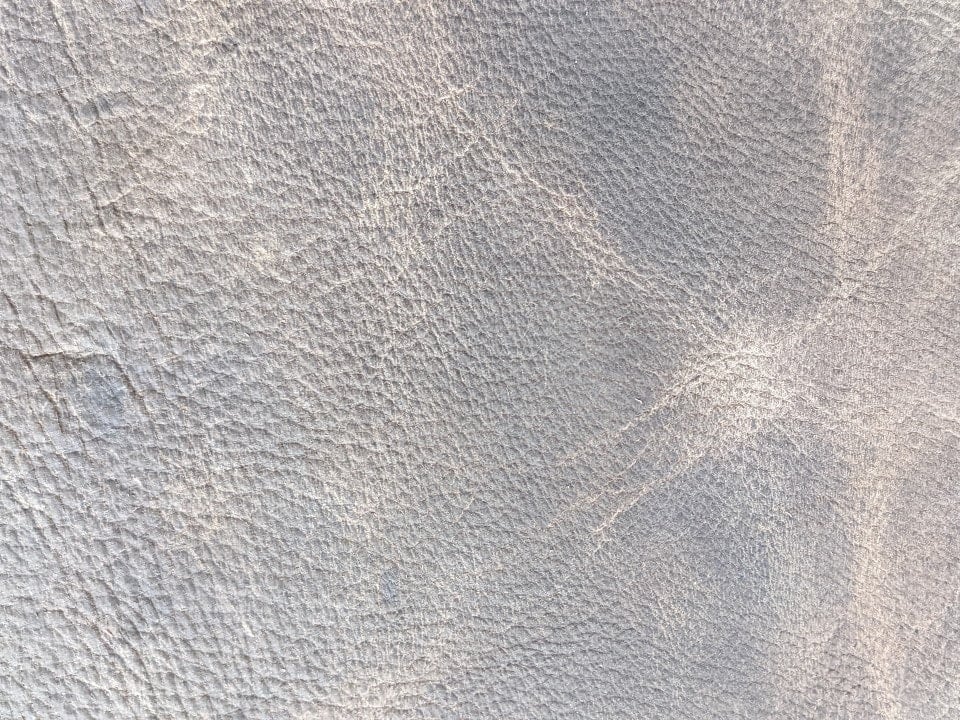
Full grain is the finest quality leather. As the name indicates, the hide and grain (skin texture) are fully intact (along with any scars or blemishes), which means only the ‘cleanest’ are used. Full-grain may be absorbent semi-aniline or aniline (referring to little or no clear finish), or it may have a more water-repellent, stain-resistant pigmented finish. Rub ‘n Restore® can be safely used on all these types of full grain leather.
Top Grain Leather
Top grain is the second best grade of leather. The outermost layer is sanded or buffed to minimize blemishes (like scars) and create a more uniform appearance. The finish may be a single solid color or have a printed, varied appearance to look like aniline, but top grain repels liquids and resists stains. Many top grain leathers have been split and the lower suede half removed. This makes a thinner, more flexible leather better suited to upholstery and luxury goods.
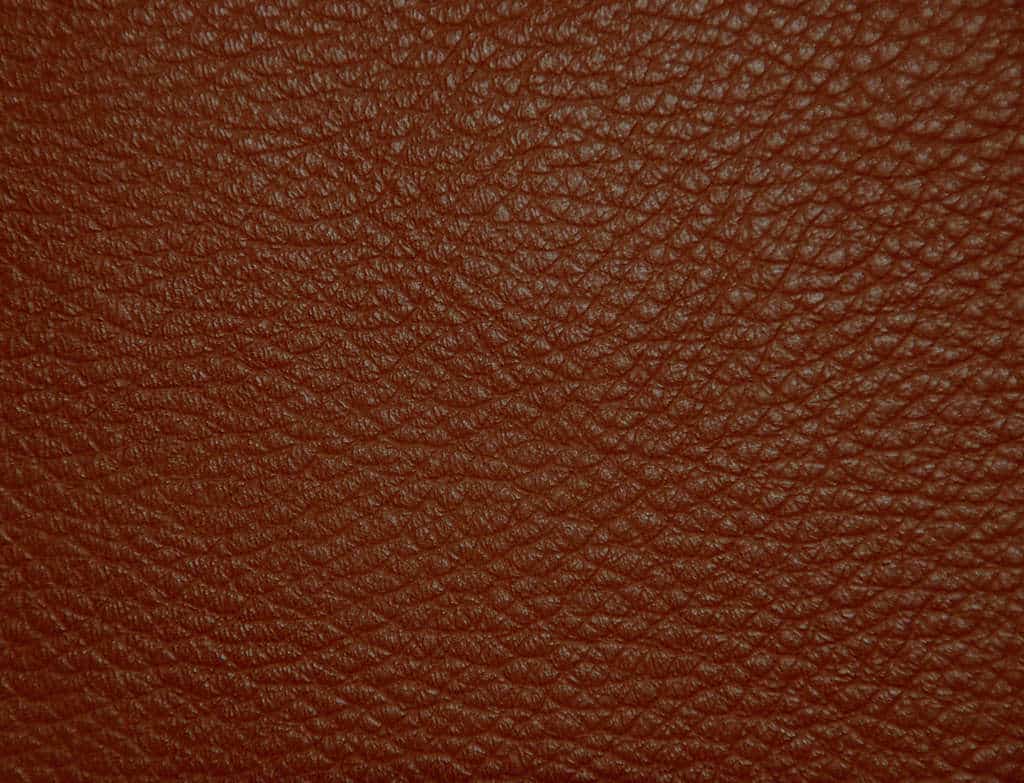
Aniline & Semi-Aniline Leather
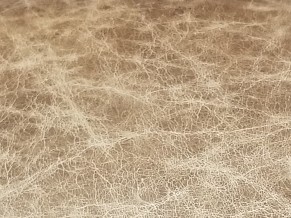
These leathers are full or top grain. The dyeing process accentuates variations in the fiber, resulting in a marbled appearance. Aniline has no clear finish and a warm, velvety texture. Semi-aniline has a thin translucent finish and a slightly cooler, smoother feel. These leathers are prized for the natural patina that develops, but their absorbency also makes them prone to stains. They also sun fade and scuff easily. As such, cleaning doesn’t improve their appearance. A thin pigmented finish, however, can and will prevent new stains or fading, even though the leather will still be absorbent and soft. However, the warm velvety feel of unfinished aniline may slightly cool to a semi-aniline texture. We recommend diluting Rub ‘n Restore® Color with Clear Prep+Finish™ to make a glaze and use a mottling technique to mimic the original marbling.
Pull-up Leather
This full grain aniline leather has a pigmented waxed or oiled finish. This will repel our water-based acrylic finish, so the leather must be deglazed before Rub ’n Restore® can be applied. As with aniline leather, we recommend diluting Color with Clear Prep+Finish™ to make a glaze and using a mottling technique to maintain the natural variation and marbling.
Nubuck
This unfinished full grain leather has been brushed. This results in a subtle nap that affects its color and appearance (similar to carpet). Nubuck has a very warm and velvety feel but is absorbent and thus prone to sun fading and stains. Our products should be used with some caution, as they will finish (or coat) the material, slightly cool its texture, and may stiffen any worn or chafed areas. We recommend working with a glaze by diluting Rub ‘n Restore® Color with Clear Prep+Finish™ and using a mottling technique to mimic the original marbling.
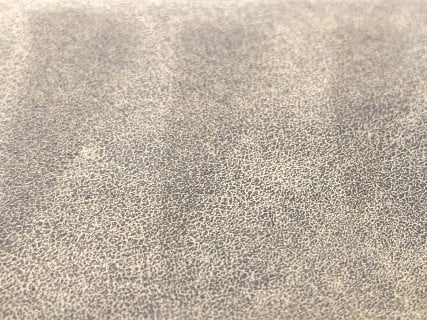
Suede
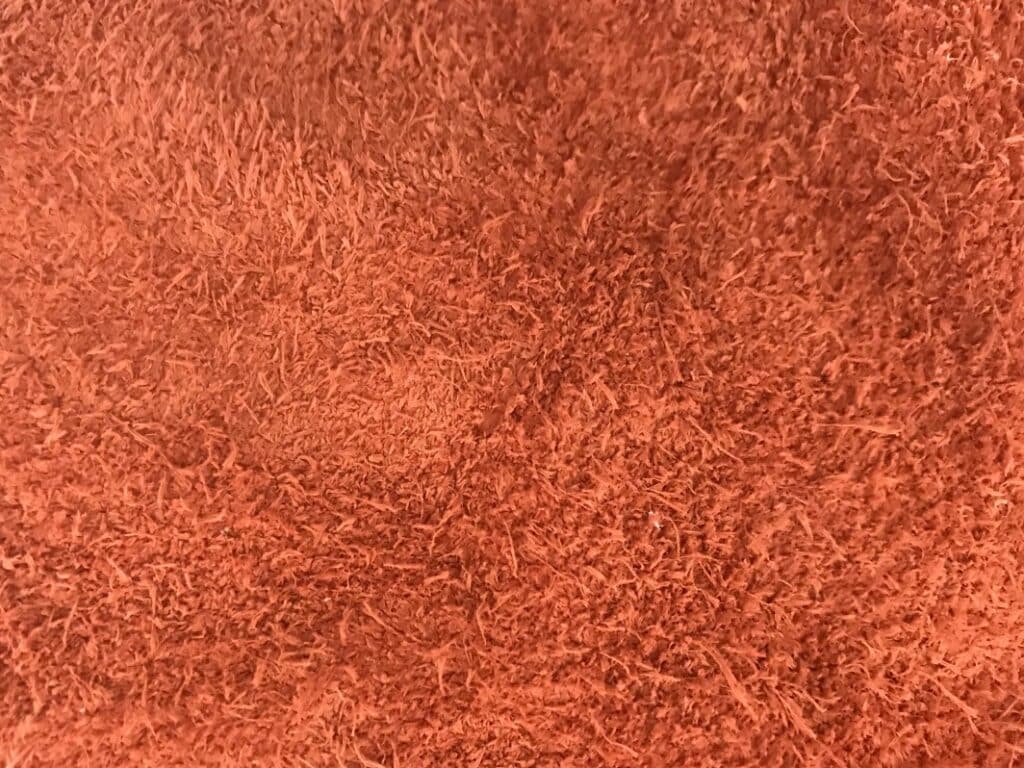
Suede is the underside of full grain leather. Many suedes have been split and separated from the top grain and thus are only the lower, weaker half of the hide. Suede has a shaggy, almost furry texture and should never be finished. Imagine latex paint on carpet.
Corrected Grain or ‘Genuine’ Leather
This top grain leather has been further sanded to correct blemishes and scars and then finished and embossed with a different grain. It is non-absorbent. Beware, types of leather fabric advertised as genuine may actually be lower-quality corrected grain.
Split Leather
This refers to the lower, weaker half of the hide that has no skin surface or grain. Unfinished, it looks like thin suede and is absorbent. Others are embossed and finished, making them non-absorbent but still of inferior quality and strength.
Bicast / Bycast Leather
This is a split hide with an artificial grain embossed into a non-absorbent urethane or polyurethane coating. These coatings eventually lose their luster and become tacky or sticky. They can also delaminate, peel or flake, exposing the split suede beneath.
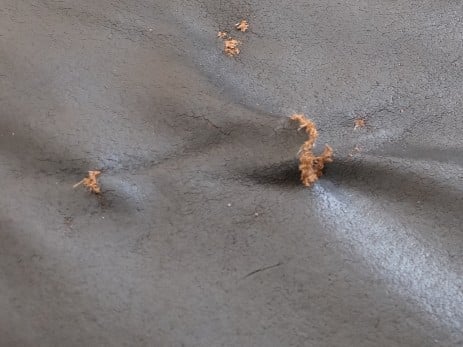
Leather Match
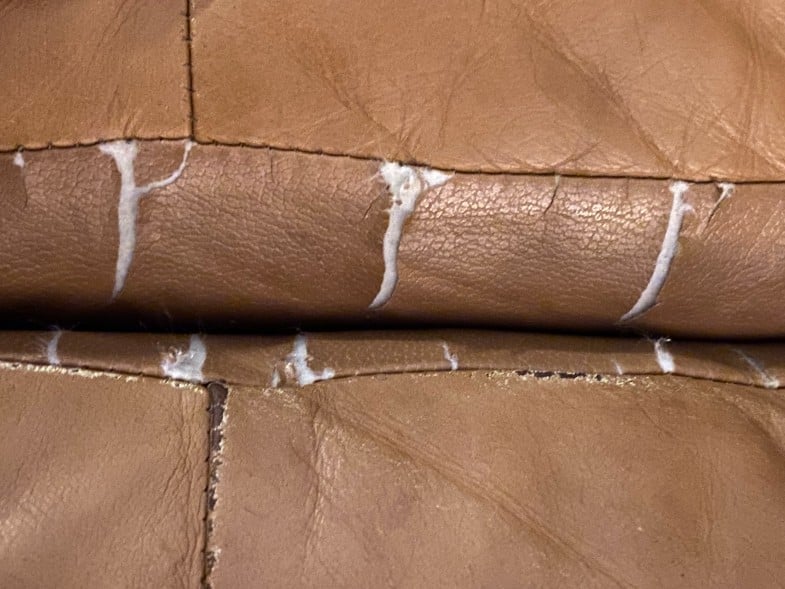
Leather upholstery is often paired with a matching synthetic on furniture and in auto interiors to reduce cost. The synthetic (usually vinyl but occasionally bonded or faux leather) is used on back and side panels where the body seldom touches. While the leather may discolor or fade, the vinyl or faux leather are often what crack, peel, or flake and require repair. Both the leather and matching vinyl are typically non-absorbent, except where worn or damaged.
Vinyl
This synthetic is made of water-repellent polyvinyl chloride (PVC). The backside of the material is a woven mesh or fuzzy polyester-cotton blend. It is used on boats and spa covers, as well as auto interiors and furniture. Naugahyde® was a trademarked name in the 1950s.
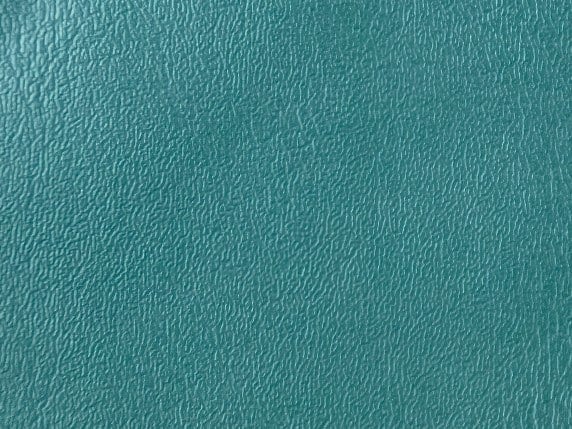
Bonded Leather
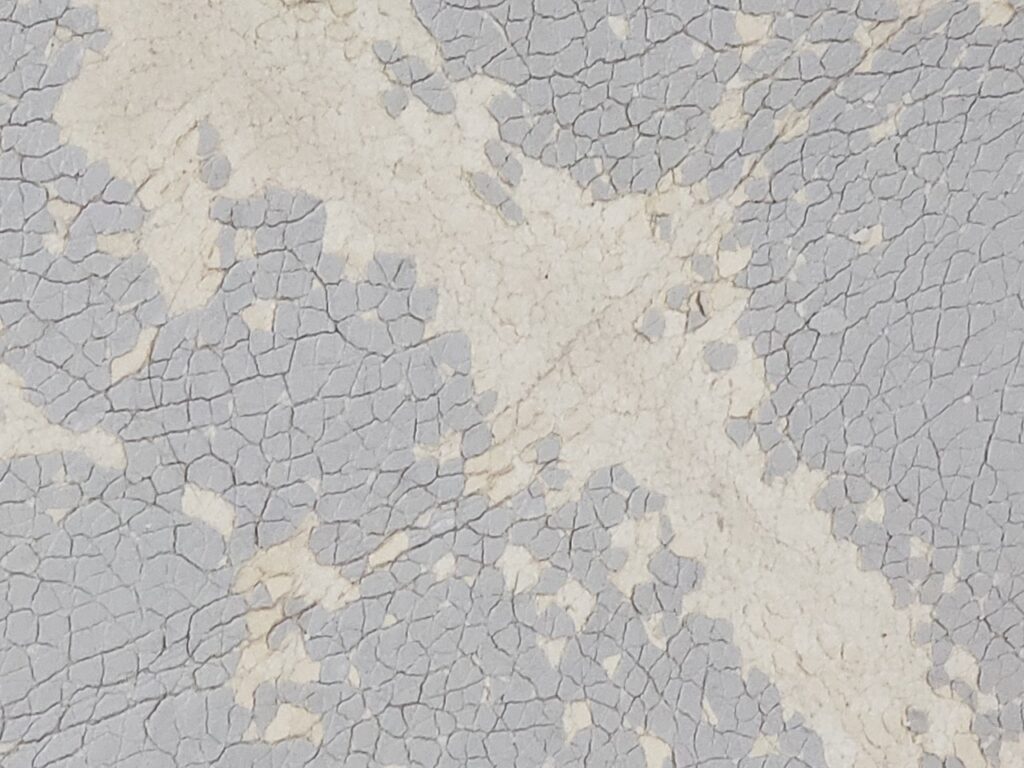
This is an inferior composite material notorious for peeling and flaking. Scrap leather is shredded, mixed with an adhesive, and rolled into a fabric which is then coated with a water-repellent polyurethane (PU) finish. This finish delaminates from the fabric. As such, repairs do not last and will not prevent further degradation. Click here to learn how you’d repair it and see the disappointing month-later result. DuraBlend® is a common brand trademarked by Ashley Furniture.
Vegan or Polyurethane Faux Leather
Faux is French for “false” and pronounced “fo”. Rayon or polyester fabric are coated with a water-repellent polyurethane coating. This coating develops hairline cracks that then peel or flake away like bonded leather, exposing the fabric. Repairs do not last because of the material’s instability. Here’s how you’d repair it, and why we don’t recommend it. Ultraleather® is a popular trademarked brand.
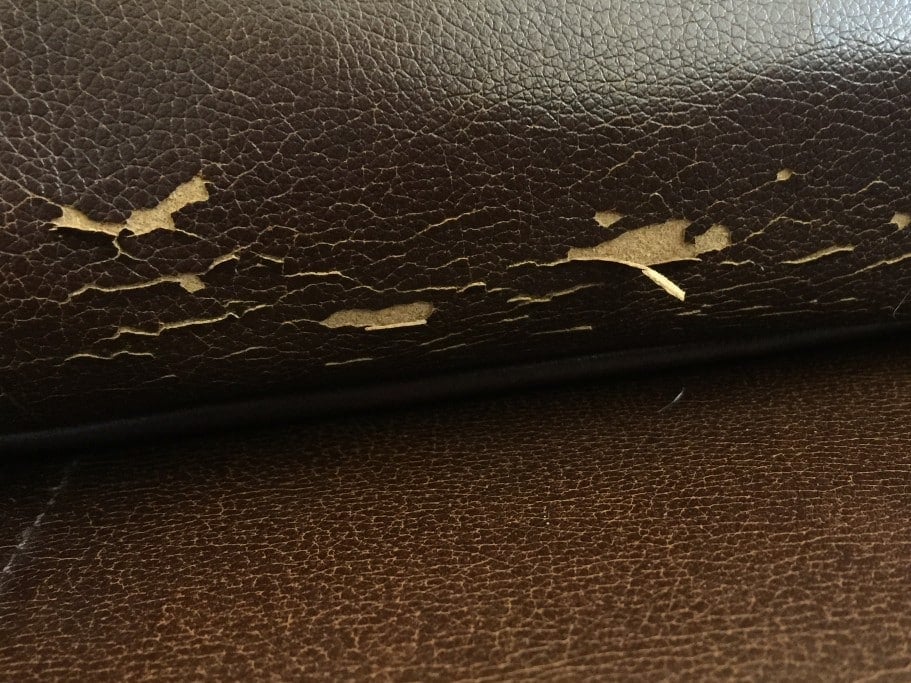
Faux Leather Fabric & Microfiber
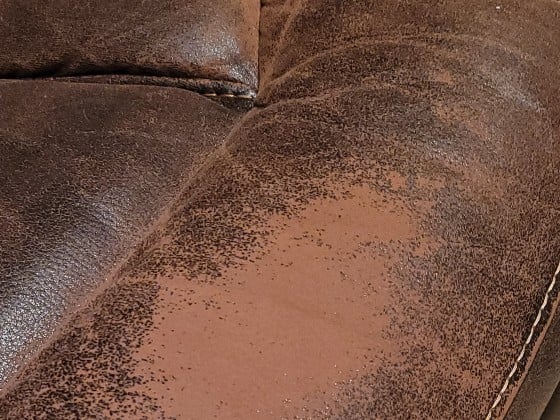
Some polyurethane faux leathers (like LeatherAire® brand) wear more naturally but still degrade from a smooth, lustrous, non-absorbent material to a fuzzier absorbent microfiber, often lighter in color. All that can be done is to stain or paint the fabric and then wax it to create a leather-like appearance.
Tanning Methods
Most upholstery leathers and garments are chromium tanned, which lends to a softer, stretchier hide.
Vegetable tanned leathers are heavy and stiff and used to make saddles, belts, and luggage.
Aldehyde or brain tanned leathers are less common, especially in upholstery.
Dyeing & Finishing
After tanning, most leathers are dyed, commonly with aniline dyes. This is confusing, because aniline and semi-aniline can refer to both the type of dye used as well as the resulting finish.
Aniline dyes are water-based and accentuate the fiber’s natural variation. Aniline-dyed leather has no protective finish.
Semi-aniline dyes have added oils which result in a translucent finish.
Aniline and semi-aniline leathers may have little or no clear finish, are absorbent and thus prone to staining and fading. Others have a pigmented, water-repellant finish (like those used in auto interiors).
Learn more about the difference between leather dyes and finishes. If you need help, consult the pro.
I have a stadium sofa piece that I got from Room to Go iij t is black and resides in my man cave/garage in the hot and humid New Orleans area. It is some type of cheap or bonded leather that is starting to wear off. Not horrible but starting. Do you have a product for this?
I could send picture if u have that ability.
You can email a picture to info@rubnrestore.com but please read/watch this first.
Does your product work on non-absorbable leather that the top layer of color has been rubbed off of?
Thank you in advance!
Yes, so long as the surface is intact, our finishes will correct discoloration. See more about spot touch-up here.
I have a recliner but am not sure what kind or leather it is but I am certain it is not absorbent, does your product work on both absorbent and none absorbent leathers? Thank you!
Yes, please read about absorbency here.
I bought an upholstered faux leather bed frame in white but the color is actually off white. I want to recolor the faux leather to a bright white so it matches my other furniture. Would I be able to use Bright White Vinyl & Leather Finish on my furniture?
If it’s vinyl (PVC), yes. If it’s polyurethane (PU), we don’t. Learn more about PU faux leather and color changing.
My new spa cover is a much lighter brown than anticipated. Can the vinyl material be darkened with your product?
Yes. Please read about changing colors here. You can order swatches.
I have a 3-seat cognac leather sofa and ottoman that I want to dye camel with your product. As well as dyeing it I’d like to make the feel warmer first. I was thinking of sanding. Will that work or can you advise a better approach?
Refinishing leather is not going to make it warmer in temperature. Sanding will remove any roughness or wear and make it feel smoother.
how big of an area does this cover. thinking of doing my hot tub cover
In general, an 8 oz. bottle covers 60 square feet, but vinyl spa covers often drink up more. This article and video have more information about restoring hot tub covers.
The seller called it “Italian leather.” When I got it home I realized that it had scales coming up on the front of the seats. Is there anything I can do to keep it from getting worse?
The leather is probably dried out and chafed or damaged by body oil. Add more batting to the cushions (if they can be unzipped) to plump them up and reduce stress on the leather. Then repair the scaliness with filler.
I have a pair 2007 car seats. The seating surfaces are leather but there is a material on the sides and back which is synthetic, but feels very similar to the leather in texture and look. It is light gray and I want to refinish it in blue. Is your “ rubnrestore” right for this application? I intend to spray the restore on.
We are not inclined to recommend color changing auto interiors with our system due to the propensity for touch-up. You’ll have less maintenance with a heavier duty acrylic-urethane blend. Try Refinish Coatings.
My father left me 2 jackets….sort of bomber style leather jackets that was very expensive (over $500). One is old and brown color worn to where it is as if there is no color at all in many areas – almost ivory.
What is the best way to restore color? It seems there was a seal or finish which isn’t shiny but not a dull mat finish either?
On the second jacket, there is no color loss yet but what is the best product to use to keep the leather soft and moist – keep from drying out? Some have said mink oil but….
Thank you so much for any help.
The faded jacket should restore beautifully with a similar brown, especially if the leather is absorbent. Beware of kidskin leather, which is very thin, soft, and stretchy. That might do better with a true dye, rather than a finish. For the unfaded jacket, we suggest ADV Leather’s Conditioner & Protector.
I inherited a recliner chair, so it is approximately 50 years old. Across the top of the chair the leather is VERY crusty and stiff, probably due to body oils and sun. The leather is not absorbent. Is there a product to make the leather soft and pliable? I have cleaned it with alcohol and water.
Also this area could use some additional batting to help with the sagging, but there is no zipper or spot to add more. The back of the chair is one piece of leather from top to bottom. Thoughts??
Thank you.
Sounds like a gentle sanding with 320 grit could help even the crustiness. Just take care not to tear up the fiber. After that I’d try some of ADV’s Leather Protector found here. Later you can fill the cracks in the leather and refinish if deemed necessary.
Impressive! Thanks for sharing this.
I have a reconstituted (I think bonded) leather couches. The problem is that they are a really light beige, and they have been looking really dirty almost from the beginning. They are really comfortable, but obviously they look dirty and I have tried everything to clean them. I would like to know if it’s possible to dye them a darker color? Thank you
Many synthetics (unless stained by rather unusual circumstances or mold), often clean up with either 409 or alcohol or both and a toothbrush. If they don’t, it’s often because the material is wearing through. With faux leathers, there are sometimes they are embossed with thousands of little pores (we’ve dubbed ‘holey ultraleather’) or the polyurethane finish wears down to fabric. In general we discourage changing color or applying much of anything to bonded, composite or faux leathers. The fabric ones are somewhat salvageable when stained / painted and coated in a clear wax. You can email a clear, close-up photo of the material’s texture to info@rubnrestore.com.
I have a 2014 528i BMW, bought it used and there is some type product on the leather door panel handle grips that is sticky/tacky and it rolls off like putty. This makes dirt and grime stains and comes off onto my hands, especially in the hot summer days. Do you have any suggestions?
I haven’t laid eyes on a 2014 model, so I’m not sure if BMW phased out the horrible decal-like coatings on the interior door handles that chipped and flaked away (VW used them too). It might just be heavy detailers’ dressing (that we derisively dub slime), in which case try stripping it off with rubbing alcohol. You may have to step up to lacquer thinner to get it off, and hopefully it doesn’t leave a white hazy mess. Even so, that could be corrected with a new finish. The only caution is to make sure you don’t start stripping off paint or decal such that you’ve got a chipped, uneven look. If you bought it used, it may have been repaired or refinished, not merely doused in slime. We can be of more help if you upload a photo.
Hello – I’m so excited to use your product! I have a TOP GRAIN leather love seat, and your website description of Top Grain Leather includes this: “top grain repels liquids and resists stains”. I’m wondering if that’s a comment about durability in that it repels liquid & resists stains from typical use, such as spilled drinks, OR, does that mean it will repel and resist me attempting to use your products to stain it a new color? Thank you for your help!
The urethane finishes used on many top grain leathers tend to repel water, liquids and other stains, which means they need to be cleaned a bit more aggressively, with our water-based cleaner followed by a solvent (rubbing alcohol at the least, denatured alcohol is good, even paint or lacquer or thinner). This repellency also means that a noticeable change of color may prove to be more maintenance than simply restoring with a matching color.